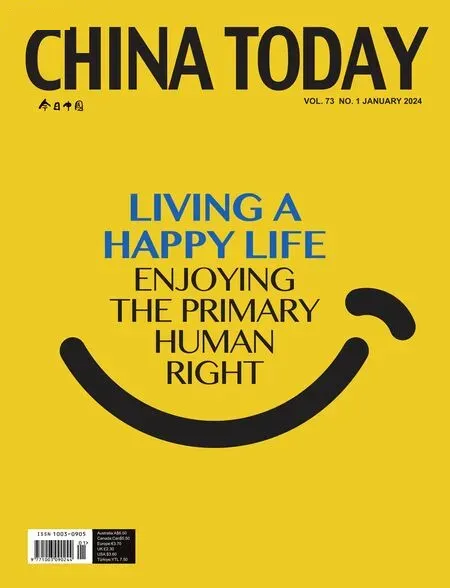Just 19: Love on the Beijing Subway
By ROBERT WALKER
Travel through Chinese culture on Beijing’s latest subway line and learn all about China.
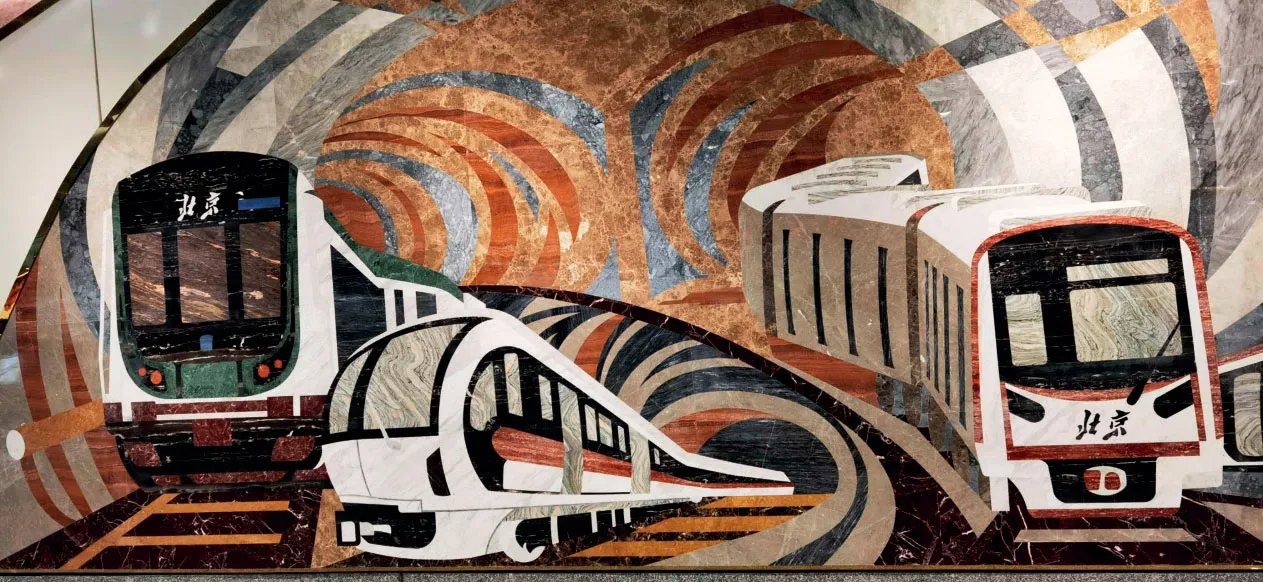
Across space and time at Beitaipingzhuang Station.
MANY foreign visitors to Beijing never travel on the city’s subway.This is a sad fact because they will never truly understand the Chinese character.
They will not meet the grandmother temporarily lost in memories of childhood back in a time when dreams were impossible since everyone was still poor and hungry.Her grandson sees things differently.He fears that if he does not make it rich in modern China,his life will be considered a failure.
Braced against the gentle motion of the carriage,two young women statuesquely pose. Dressed in traditionalqipao,their elegant gowns almost cover the trainers on their feet.
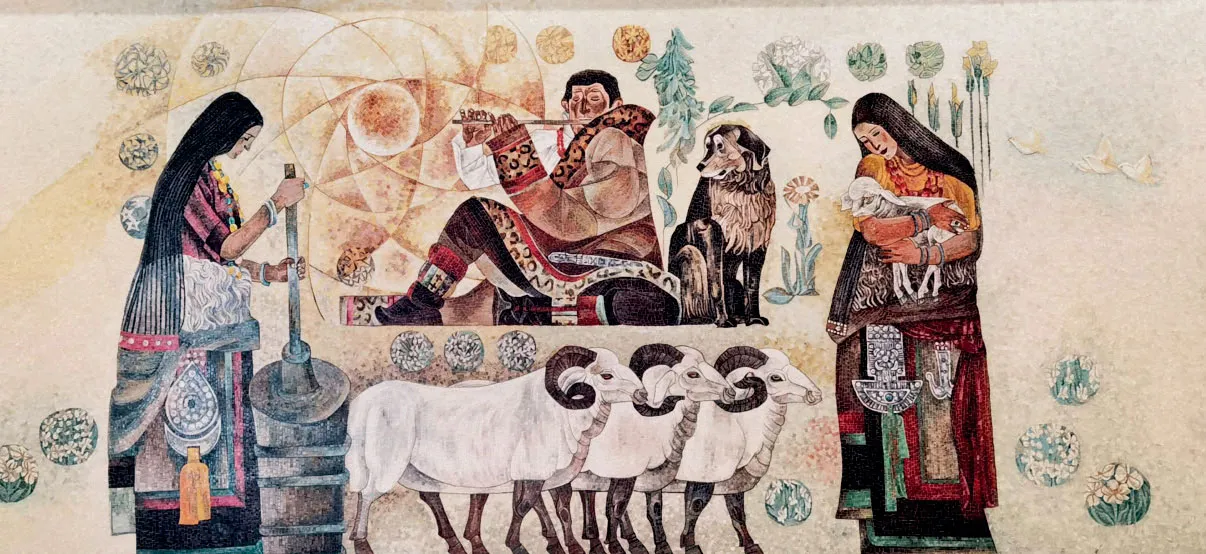
Celebrating China’s ethnic diversity at Niujie Station.
Sitting opposite,a migrant from the countryside is concentrating on his mobile phone,his tough clothes somewhat threadbare.Is he going to work or travelling home? It could be either,whatever the time of day. His extended fam-ily depends on his endless labor.So,too,does every Beijing resident.
Travelling by subway is also to appreciate the relationship between government and the people,one based on mutual trust and respect. Some suggest that it derives from a love of China.
Hence,Line 19– the newest addition–is not just a transit line running north-south. Rather it is a statement that the people deserve the best that China’s development and technology can offer. It is also a celebration of Chinese culture
To begin with the technology. As Beijingers would expect,the rolling stock is smooth,energy efficient and welcoming:brightly colored plastic seats;elsewhere–if preferred–soft subdued furnishings.
motif
The motif chosen by artists Sun Tao and Sun Ying is the graceful curve of the subway tunnel,repeated multiple times across vast murals in natural browns,ochres,greys,and white.
The technology is people focused.Screens above train doors not only indicate the next stop but the two after that.Prior to arrival at a station,they locate where the carriage will come to rest,its spatial relationship to escalators leading to exits and transfers.This is ergonomically efficient;it prevents lost individuals from clogging up the walkways.It also says,“This subway is for you!” Indeed,the digital screens even locate station toilets and baby changing facilities.
Travelling the 10 stations of Line 19,one enters a time capsule journeying through Chinese history. The line takes travelers south from north of the third ring road in Haidian to the Daxing Airport Express and a little beyond.But it also carries them to the outer reaches of China’s cultural universe through the medium of public art.
Every station is a free gallery.Beitaipingzhuang is an ideal place to board the time capsule since its art is themed “Across Time and Space.” It rejoices in the history of the transit system itself and does so with consummate skill and panache.
The motif chosen by artists Sun Tao and Sun Ying is the graceful curve of the subway tunnel,repeated multiple times across vast murals in natural browns,ochres,greys,and white.Generations of subway cars seem to career through imagined tunnels,only to leap from the walls with unstoppable ease.
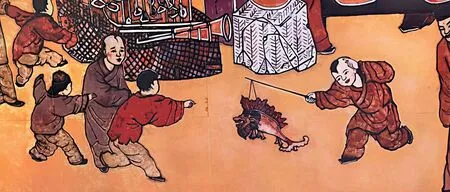
Children playing in the market during the Ming Dynasty,Ping’anli Station.
The natural colors are woven together from almost 100 marbles sourced from around the world,each piece cut with precision to dovetail with its partners.Spectacular technology but,characteristic of China’s socialist art,man and workers are rendered too. On their stomachs they seem to crawl,tools in hand,inching forward,opening up the earth.Elsewhere,in teams,they are seen installing the track and engineering that take us where we want to go.
The story of development takes on a different hue at Taipingqiao Station.Surely incredulous to Western eyes,Qiu Zhijie has taken China’s 14th Five-Year Plan as the foundation of his artwork,reimagining the plan as a meandering river marked on an ancient map.
Peering closely,we find fields and buildings labelled as if with an ink-dipped brush.The labels read: social welfare reform;labor contract system,state-owned enterprise reform and much more besides.Policy is informing art;perhaps art is teaching travellers.
Elsewhere in Taipingqiao Station,Qiu Zhijie pays homage to history’s metal workers,capturing economic progress in the fields of agriculture,trade,transport,and finance.Embossed on copper sheets,sailing ships joust for position in the wind. Maize cobs wait to be harvested,the burnished metal creating impressions of sunset.
Good harvests have always been a time for dancing.These celebrations are captured in all their vitality across the glass mosaics that adorn Niujie Station.The centrepiece is the mural “Creation,Harvest,Joy,” originally designed by the husband-and-wife team,Liu Bingjiang and Zhou Ling,for the Beijing Hotel in 1982.
Zhou Ling,who taught at what is now Minzu University of China,had previously spent eight years living among various minority groups in Yunnan Province.Her understanding and affection for ethnic difference is evident in the detailed portrayal of dancers from diverse cultures;they step out as one to tunes played on folk instruments.
fruit
Apparently freed from gravity,the fruit medley jostle with floating people all observed by a mischievous cat with enormous eyes.
But Niujie Station has so much more to offer in celebration of China’s ethnic diversity.Multiple mosaics,some attributed Liu Hua,capture–in elegant detail–lifestyles and work practices from Tibet to Inner Mongolia.We see horsemen,shepherds,herders,wine growers,and fruit pickers–but also children studying books on their knees.
Li Qing and Chen Shihui have transformed Xinfadi Station into a festival of color with the fruits of harvest: apples,peaches,oranges,and watermelons large enough to walk through.Apparently freed from gravity,the fruit medley jostle with floating people all observed by a mischievous cat with enormous eyes.Elsewhere,a modern couple sip cool drinks beneath a sunshade,their peace restored in the heat of summer.
The stop at Ping’anli Station is a trip into history back to the Ming Dynasty (1368-1644).This was a time of relative prosperity and great inventions.Two rice harvests each year enabled the population to double to 108 million by 1086,four times that in Europe.Poverty retreated,cities formed,and markets–such as the one captured by artist Ye Jianqing–bustled.

Combining old and new at Ping’anli Station.
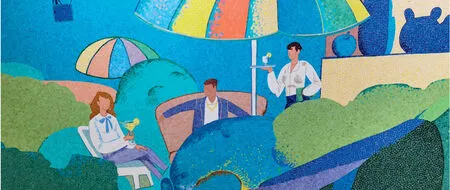
Modern city life at Jingfengmen Station.Photos courtesy of Robert Walker
Reproduced,as if in oil paint on newly invented paper,the Lantern Festival is in full swing here.Hundreds of people throng the market streets with lanterns on sticks or left to float skywards. But truth lies in the details: urchins playing with toys;goldfish caught with spoons;and the total absence of women seen in a public place.
For modernity,get off at Jingfengmen Station and admire the murals there.Highrise buildings,pastel in color,are silhouetted against a deep blue evening sky.Yet,history is still present.The You’anmen city gate,demolished in 1958,is etched between flying doves and a crescent moon.
Citylife at Jingfengmen Station is not harsh nor are the streets dirty.Rather with a mix of glass mosaic and ceramic reliefs,artists Wang Changxing and He Liang remind us of Beijing’s countless parks.Beneath willow trees,caged birds seem to swing and sing,while swallows loop and shiny magpies zoom.
Stop again at Ping’anli Station,this time for a touch of nostalgia.Courtyards,grey walls,pantile roofs and bright red doors are recreated by Zhao Jianfeng and Li Jing from high-temperature glazed ceramics.Although entitled ‘Yushu in the wind,’ the images are reminiscent of Beijing’shutongs.It is certainly spring,magnolia is in blossom,and pigeons are cooing for a mate.
Nostalgia and tradition are evident elsewhere.The peony is a symbol of prosperity and wealth in China,red for the emperor,white for the beauty and happiness of young women.The Chinese for peony ismudan,known as “queen of flowers” in China.Hence,peonies in all their magnificence are on display at Mudanyuan Station.
The Chinese koi,or carp,is also a symbol of wealth and power–the words for fish and abundance sharing the same sound,yu,in Mandarin.Koi can be found in great abundance at Jishuitan Station where He Wei and Zhang Junqing have created perhaps the most spectacular of all the Line 19 murals.Wrapped around a curved corridor,mosaic water seems to flow to infinity,fish glinting as they glide in and out of river weed.Technology lies behind the glistening art,aluminum reflecting light back through aquamarine tesserae.
A third visit to Ping’anli Station is essential.An atrium,as high as a gothic cathedral,catches daylight that is augmented by a host of decorated box lanterns that cite the Ming Dynasty.Stand in awe for this is modern China!

